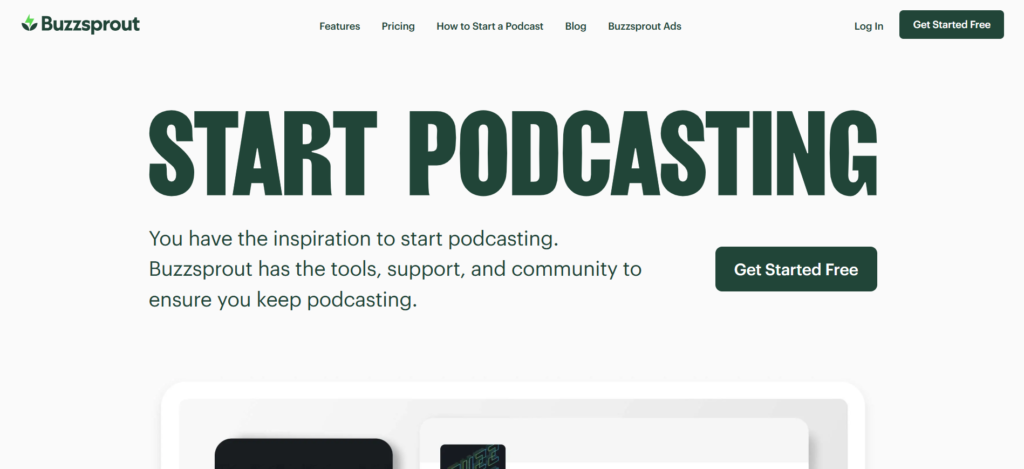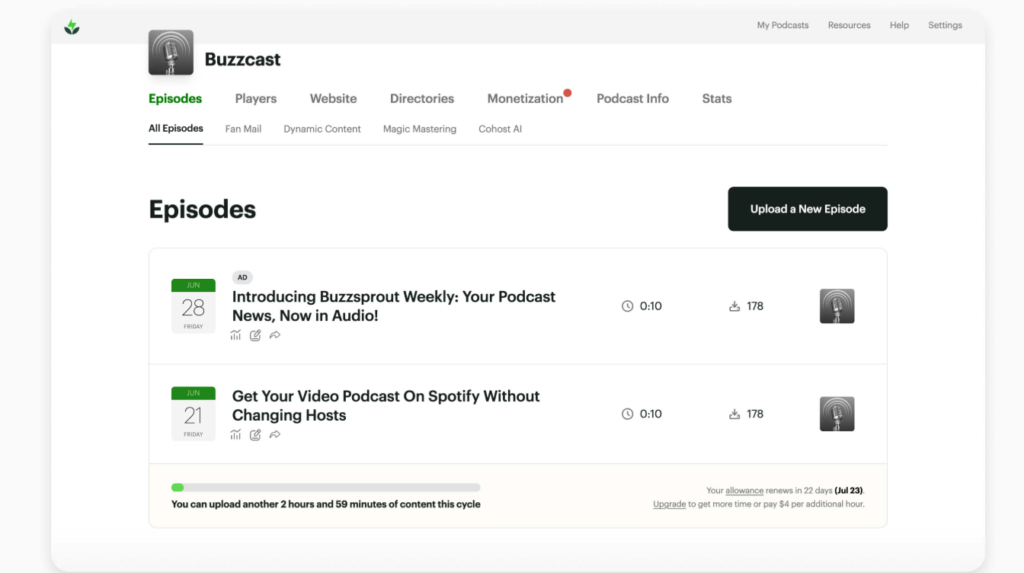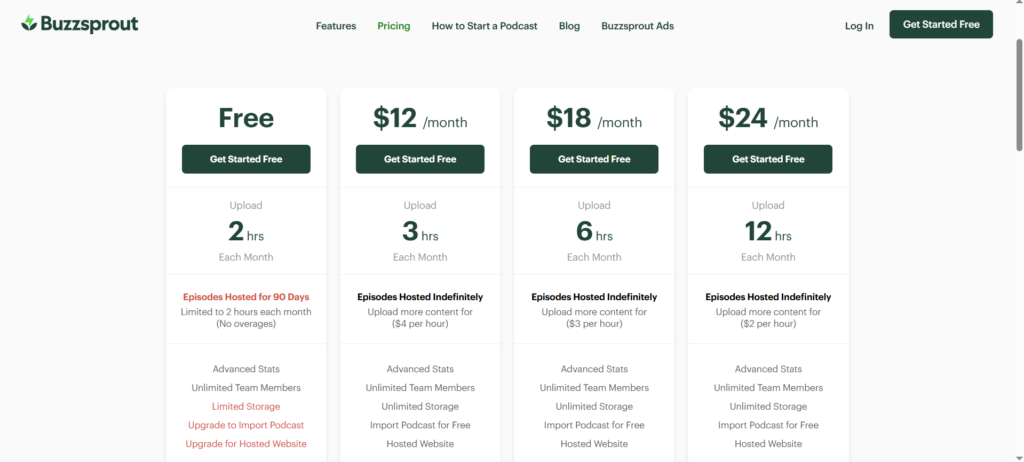Buzzsprout Review
Podcasting has exploded in popularity over the past decade, transforming from a niche medium into a global phenomenon that reaches millions of listeners daily. Whether you’re a hobbyist sharing your passion, a business promoting your brand, or a creator aiming to monetize your content, choosing the right podcast hosting platform is a critical decision. Among the many options available, Buzzsprout consistently ranks as a top contender. But does it live up to the hype? In this Buzzsprout review, we’ll dive deep into its features, usability, pricing, pros, cons, and real-world performance to help you decide if it’s the right fit for your podcasting journey in 2025.
What Is Buzzsprout?

Buzzsprout is a podcast hosting platform launched in 2009, designed to simplify the process of creating, publishing, promoting, and tracking podcasts. With over 120,000 active podcasters and millions of downloads facilitated each month, Buzzsprout has built a reputation as one of the easiest and most reliable platforms on the market. Headquartered in Jacksonville, Florida, the company prides itself on its user-friendly interface, robust feature set, and exceptional customer support—attributes that have earned it thousands of five-star reviews across platforms like Trustpilot and G2.
Unlike some competitors that focus solely on hosting audio files, Buzzsprout aims to be an all-in-one solution. It provides tools for distribution to major directories (like Apple Podcasts, Spotify, and Google Podcasts), detailed analytics, website creation, and even monetization options. Whether you’re a beginner dipping your toes into podcasting or a seasoned creator looking for a streamlined workflow, Buzzsprout promises to deliver. But how well does it actually perform? Let’s break it down.
How to start a Podcast with Buzzsprout
One of Buzzsprout’s standout qualities is how easy it is to get started. Signing up takes just a few minutes. You can begin with a free plan (more on that later) or jump straight into a paid tier. Once you’ve created an account, Buzzsprout guides you through the setup process with a clean, intuitive dashboard.
Setting Up Your Podcast
If you’re launching a new podcast, Buzzsprout prompts you to enter basic details: your podcast title, description, category, and artwork. These fields align with the requirements for major directories like Apple Podcasts, ensuring your RSS feed is compliant from the get-go. If you already have an existing podcast hosted elsewhere, Buzzsprout offers a seamless migration tool. Simply input your current RSS feed or search for your show in Apple Podcasts, and Buzzsprout will import your episodes, preserving your metadata and redirecting your feed to avoid losing subscribers.
The setup process is refreshingly straightforward. For beginners, this eliminates the intimidation factor often associated with technical jargon like RSS feeds or ID3 tags. Buzzsprout handles the heavy lifting, allowing you to focus on creating content.
Uploading Your First Episode
Uploading an episode is equally simple. From the “Episodes” tab, you click “Upload New Episode,” select your audio file, and fill in details like the title, description, and episode number. Buzzsprout supports a variety of file formats and automatically converts them to 96kbps mono MP3—a widely accepted standard for podcasts that balances quality and file size. If you need higher quality (e.g., for music-heavy shows), you can opt for their 192kbps stereo plan with the Magic Mastering add-on (more on pricing later).
Once uploaded, you can choose to publish immediately, schedule for a future date, or save as a draft. Buzzsprout also emails you a confirmation with handy details like embed codes and your remaining upload time—small touches that enhance the user experience.
Key Features of Buzzsprout

Buzzsprout isn’t just a hosting service; it’s a comprehensive toolkit for podcasters. Here’s a closer look at its core features and how they perform in practice.
1. Ease of Use
Buzzsprout’s interface is a masterclass in simplicity. The dashboard is well-organized, with tabs for Episodes, Podcast Settings, Directories, Statistics, and more, all clearly labeled and easy to navigate. Whether you’re uploading files, editing episode details, or checking analytics, every action feels intuitive. This makes it an ideal choice for beginners who might feel overwhelmed by more complex platforms like Libsyn or Podbean.
For example, adding chapter markers—a feature supported by many podcast apps—is a breeze. You can insert timestamps and titles directly in the episode editor, enhancing the listener experience without needing external software.
2. Distribution to Podcast Directories
Getting your podcast listed on major platforms is crucial for reaching an audience, and Buzzsprout excels here. The “Directories” tab provides step-by-step instructions for submitting your show to Apple Podcasts, Spotify, Google Podcasts, Amazon Music, Stitcher, and more. While some directories require manual submission, Buzzsprout pre-populates your RSS feed and offers a “Validate and Submit” button for Apple Podcasts, making the process as painless as possible.
Once approved, new episodes automatically sync to all connected directories, saving you from repetitive manual uploads. This hands-off approach is a time-saver for busy podcasters.
3. Podcast Website and Embeddable Players
Buzzsprout includes a basic podcast website with every plan, complete with customizable show notes, subscription buttons, and sharing options. While it’s not as flexible as a self-hosted WordPress site, it’s a solid starting point for newbies who don’t yet have their own domain. You can preview how it looks by checking out Buzzsprout-hosted shows like the Podcasting Simplified Podcast.
For those with existing websites, Buzzsprout offers embeddable players in two flavors: a single-episode player for blog posts and a multi-episode player for a dedicated podcast page. These players are sleek, customizable (e.g., colors and artwork), and responsive, ensuring they look great on any device.
4. Advanced Analytics
Understanding your audience is key to growing your podcast, and Buzzsprout’s statistics are both comprehensive and user-friendly. The “Statistics” tab provides a snapshot of your total downloads, average listens per episode, and trends over 7, 30, 90 days, or lifetime. You can drill down into specifics like listener locations, device types, and podcast apps, giving you actionable insights into your audience’s behavior.
A unique feature is Buzzsprout’s “Listeners” metric, which estimates how many people tuned in within the first 90 days of an episode’s release. While not every platform offers this, it’s a helpful gauge for measuring engagement. The stats are presented with colorful charts and a clean layout, making them easy to digest at a glance.
5. Magic Mastering (Optional Add-On)
For an extra $6/month, Buzzsprout’s Magic Mastering enhances your audio quality by normalizing levels, reducing noise, and applying a professional polish—think of it as an “Instagram filter for your audio.” It’s not a replacement for skilled editing software like Adobe Audition, but it’s a godsend for beginners or those with minimal production experience. The feature also unlocks 192kbps stereo encoding, ideal for high-fidelity content.
In practice, Magic Mastering works well for spoken-word podcasts, smoothing out inconsistencies without requiring technical know-how. However, if you’re already proficient in audio production, you might skip this add-on and handle mastering yourself.
6. Monetization Options
Buzzsprout offers several ways to monetize your podcast. Its Affiliate Marketplace connects you with brands like Amazon, Shure, and Blue Microphones, allowing you to earn commissions without a minimum audience size. Unlike some platforms, Buzzsprout takes no cut of your earnings, which is a big plus.
You can also add pre-roll or mid-roll ads manually, integrate sponsor links in episode descriptions, or link to donation platforms like Patreon or Buy Me a Coffee. While Buzzsprout doesn’t offer dynamic ad insertion like larger platforms (e.g., Spotify for Podcasters), its flexibility suits creators who prefer a DIY approach to monetization.
7. Episode Transcriptions
Buzzsprout provides automated transcriptions for $0.08 per minute, making your episodes searchable and accessible to hearing-impaired listeners. The transcripts are decently accurate for clear audio, though they may struggle with accents or background noise. This feature boosts SEO and inclusivity, though it’s an additional cost to consider.
Pricing Plans

Buzzsprout’s pricing is based on monthly upload hours rather than file size or downloads, making it straightforward to predict costs. As of March 21, 2025, here are the options:
- Free Plan: 2 hours of uploads per month, episodes hosted for 90 days only. No monetization or advanced features.
- $12/month: 3 hours of uploads per month, unlimited hosting.
- $18/month: 6 hours of uploads per month, unlimited hosting.
- $24/month: 12 hours of uploads per month, unlimited hosting.
Additional upload hours cost $4/hour if you exceed your limit. The Magic Mastering add-on is $6/month, and there’s an Archive Plan ($5/month) to keep episodes live during a hiatus without losing unused upload time.
Compared to competitors, Buzzsprout is moderately priced. Libsyn offers unlimited uploads for $20/month but lacks some of Buzzsprout’s ease-of-use features, while RedCircle provides free hosting with monetization for growing shows. Buzzsprout’s value shines for small to medium-sized podcasts, though heavy uploaders might find better deals elsewhere.
New users also get a $20 Amazon gift card with any paid plan—a nice perk to offset the initial cost.
Pros and Cons of Buzzsprout
Pros
- User-Friendly: Perfect for beginners with zero technical experience.
- Great Support: Responsive customer service via email and a wealth of tutorials.
- Robust Features: Analytics, transcriptions, and distribution tools are top-notch.
- Flexible Monetization: Affiliate marketplace and donation links with no commission fees.
- Free Website: A simple, functional site included with every plan.
Cons
- Pricing Limits: Upload caps might not suit prolific podcasters.
- Limited Free Plan: Episodes expire after 90 days, and features are restricted.
- No Dynamic Ads: Lacks automated ad insertion for passive income.
- Basic Website Customization: The included site lacks advanced design options.
Who Is Buzzsprout Best For?
Buzzsprout shines brightest for:
- Beginners: Its simplicity and guided setup remove barriers to entry.
- Hobbyists: Affordable plans suit casual podcasters with modest upload needs.
- Small Businesses: The website and analytics help establish a professional presence.
Experienced podcasters with high upload volumes or advanced monetization goals might outgrow Buzzsprout, favoring platforms like Libsyn or Transistor instead.
Final Verdict: Is Buzzsprout Worth It in 2025?
After exploring Buzzsprout’s features, pricing, and user feedback, it’s clear why it’s a perennial favorite. It strikes an excellent balance between ease of use and functionality, making podcasting accessible without sacrificing essential tools. The platform’s clean design, reliable distribution, and detailed analytics empower creators to focus on content rather than logistics. While it’s not the cheapest option and lacks some advanced features like dynamic ads, its value proposition is hard to beat for most users.
If you’re starting your podcasting journey or seeking a hassle-free hosting solution, Buzzsprout is a stellar choice. Its free plan lets you test the waters, and the $20 Amazon gift card sweetens the deal for paid subscribers. For those with niche needs (e.g., unlimited uploads or automated monetization), it’s worth comparing alternatives. But for the majority of podcasters in 2025, Buzzsprout delivers on its promise: it’s the easiest way to host, promote, and track your podcast.
